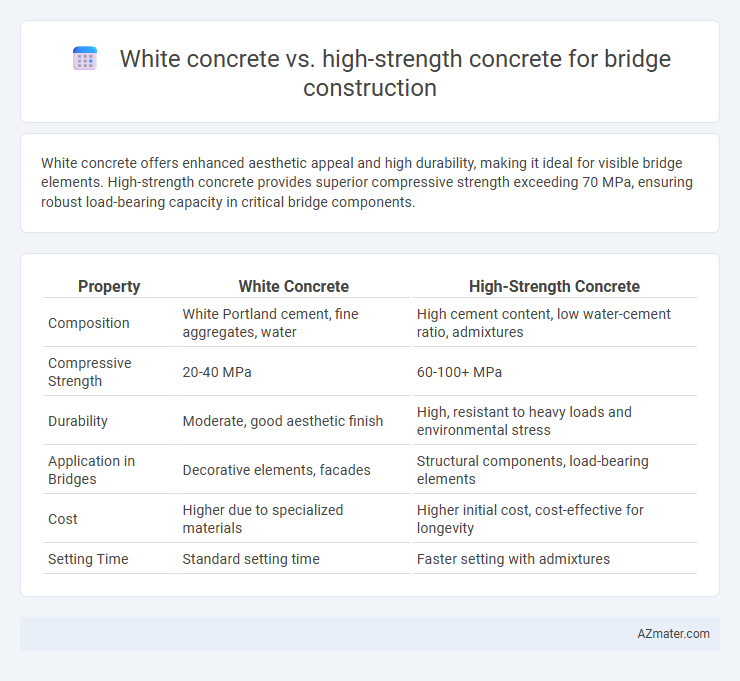White concrete offers enhanced aesthetic appeal and high durability, making it ideal for visible bridge elements. High-strength concrete provides superior compressive strength exceeding 70 MPa, ensuring robust load-bearing capacity in critical bridge components.
Table of Comparison
| Property | White Concrete | High-Strength Concrete |
|---|---|---|
| Composition | White Portland cement, fine aggregates, water | High cement content, low water-cement ratio, admixtures |
| Compressive Strength | 20-40 MPa | 60-100+ MPa |
| Durability | Moderate, good aesthetic finish | High, resistant to heavy loads and environmental stress |
| Application in Bridges | Decorative elements, facades | Structural components, load-bearing elements |
| Cost | Higher due to specialized materials | Higher initial cost, cost-effective for longevity |
| Setting Time | Standard setting time | Faster setting with admixtures |
Introduction to Concrete Types in Bridge Construction
White concrete offers aesthetic appeal and reflective properties, making it ideal for architectural bridge elements, while high-strength concrete provides superior compressive strength and durability essential for structural components under heavy loads. In bridge construction, selecting between white concrete and high-strength concrete depends on balancing visual requirements with load-bearing performance. High-strength concrete typically exceeds 6,000 psi, enhancing resistance to environmental stressors, whereas white concrete's composition is tailored for color consistency and light reflectivity.
Overview of White Concrete
White concrete, distinguished by its aesthetic appeal and high reflectivity, is primarily used in architectural bridge applications where visual impact is crucial. Composed of white Portland cement, light-colored aggregates, and high-quality materials, it ensures durability and reduced heat absorption while maintaining structural integrity. This type of concrete also offers enhanced resistance to weathering and chemical attacks, making it suitable for exposed bridge surfaces requiring both strength and visual distinction.
Overview of High-Strength Concrete
High-strength concrete (HSC), characterized by a compressive strength typically above 6,000 psi (41 MPa), offers enhanced durability and load-bearing capacity essential for modern bridge construction. Unlike white concrete, which prioritizes aesthetic appeal with the use of white Portland cement and reflective aggregates, HSC emphasizes mechanical performance, enabling longer spans, reduced section sizes, and improved resistance to environmental stressors. The superior density and low permeability of high-strength concrete contribute to extended service life and reduced maintenance costs in bridge structures.
Key Material Properties Compared
White concrete exhibits lower compressive strength, typically around 20-40 MPa, compared to high-strength concrete, which can exceed 70 MPa, making the latter more suitable for heavy load-bearing in bridge construction. Durability factors such as reduced permeability and enhanced resistance to chemical attacks are more pronounced in high-strength concrete due to its dense microstructure. The aesthetic advantage of white concrete lies in its superior color consistency and reflectivity, which can be beneficial for architectural bridge elements requiring a clean appearance.
Durability and Longevity Analysis
White concrete offers enhanced aesthetic appeal and moderate durability suitable for architectural bridge elements, while high-strength concrete provides superior compressive strength exceeding 60 MPa, significantly improving load-bearing capacity and resistance to environmental stressors. In terms of durability, high-strength concrete exhibits lower permeability and higher resistance to chloride penetration, reducing corrosion risks of reinforcing steel and extending the service life of bridge structures. Longevity analysis confirms that bridges constructed with high-strength concrete can achieve service lives exceeding 75 years under aggressive conditions, whereas white concrete is generally preferred for visible components where durability demands are less critical.
Aesthetic Considerations in Bridge Design
White concrete offers superior aesthetic appeal in bridge design with its bright, clean appearance and uniform color, enhancing visual integration with urban and natural landscapes. High-strength concrete prioritizes structural performance, providing enhanced durability and load-bearing capacity but often features a darker, less uniform color that may require surface treatments to improve appearance. Selecting white concrete supports architectural expression and visual impact, while high-strength concrete ensures long-term functionality and maintenance efficiency in bridge construction.
Structural Performance and Load-bearing Capacity
White concrete offers enhanced aesthetic appeal with moderate load-bearing capacity, making it suitable for decorative bridge components, while high-strength concrete delivers superior compressive strength exceeding 60 MPa, essential for primary structural elements under heavy loads. High-strength concrete's reduced porosity and increased durability improve resistance to environmental stressors, ensuring long-term structural integrity and safety in bridge construction. Despite its aesthetic limitations, high-strength concrete is preferred for load-bearing capacity and overall performance in critical infrastructure.
Cost Implications and Budget Considerations
White concrete typically incurs higher material costs due to the use of refined white cement and pigments, making it less economical for large-scale bridge construction projects. High-strength concrete, while more expensive than standard mixes, offers cost savings over time through enhanced durability and reduced maintenance requirements, favoring budget-conscious infrastructure planning. Project specifications and lifespan expectations critically influence the cost-benefit analysis between white concrete and high-strength concrete in bridge applications.
Environmental Impact and Sustainability
White concrete, known for its aesthetic appeal and reflective properties, typically has a lower embodied carbon footprint compared to high-strength concrete due to its reduced cement content and use of alternative materials like white cement or limestone fillers. High-strength concrete, while offering superior structural performance and durability, often requires higher cement proportions and energy-intensive production processes, potentially increasing its environmental impact. Sustainable bridge construction increasingly favors formulations that balance the durability and load-bearing advantages of high-strength concrete with eco-friendly additives and recycling practices to minimize carbon emissions and resource depletion.
Application Suitability: Which Concrete for Your Bridge Project?
White concrete offers excellent aesthetic appeal and is ideal for architectural bridge elements requiring a bright, clean finish, while high-strength concrete provides superior load-bearing capacity essential for structural components in heavy-traffic bridges. High-strength concrete, with compressive strengths often exceeding 70 MPa, is better suited for long-span bridges and critical load zones due to its enhanced durability and resistance to environmental stressors. Selecting the appropriate concrete depends on balancing visual requirements with structural demands to ensure both performance and longevity of the bridge.

Infographic: White concrete vs High-strength concrete for Bridge construction
 azmater.com
azmater.com